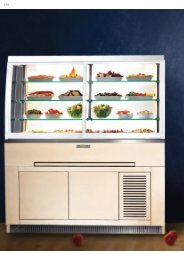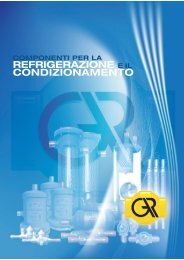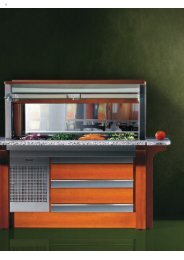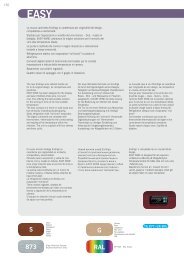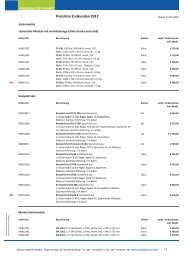Made in Japan
Made in Japan
Made in Japan
You also want an ePaper? Increase the reach of your titles
YUMPU automatically turns print PDFs into web optimized ePapers that Google loves.
Unità di recupero calore / heat Recovery units<br />
Unità di recupero Calore<br />
Heat Recovery Units<br />
uRC · uRCv<br />
Configurazioni Recuperatore di Calore<br />
versione orizzontale URC<br />
Il recuperatore di calore è disponibile <strong>in</strong> due configurazioni base, tipo A e C.<br />
Nella configurazione di tipo A il recuperatore di calore ha i ventilatori <strong>in</strong>stallati<br />
l’uno opposto all’altro vedi la posizione della mandata dell’aria di r<strong>in</strong>novo e<br />
l’espulsione dell’aria viziata.<br />
Nella configurazione di tipo C il recuperatore di calore ha i ventilatori<br />
<strong>in</strong>stallati nello stesso lato e pertanto anche la mandata dell’aria di r<strong>in</strong>novo e<br />
l’espulsione dell’aria viziata. Nel caso sia necessario <strong>in</strong>stallare la batteria di<br />
post-riscaldamento ad acqua o elettrica le configurazioni possibili diventano<br />
quattro: tipo A, B, C e D.<br />
La differenza tra la configurazione di tipo A e B è la posizione della batteria di<br />
post-riscaldamento, <strong>in</strong>stallata <strong>in</strong>ternamente, legata all’ubicazione del canale<br />
dell’aria di r<strong>in</strong>novo.<br />
Nel caso non si preveda alcuna batteria di post-riscaldamento il recuperatore<br />
di calore di tipo A può essere ruotato di 180° <strong>in</strong> relazione alle esigenze<br />
impiantistiche, fig. A1 e A2. Se prevista la batteria di post-riscaldamento è<br />
<strong>in</strong>dispensabile utilizzare il tipo A per l’<strong>in</strong>stallazione rappresentata <strong>in</strong> fig. A1 ed<br />
il tipo B per quella rappresentata <strong>in</strong> fig.A2. In quest’ultima l’unità è ruotata di<br />
180° ma è cambiata anche la posizione della batteria di post-riscaldamento per<br />
immettere l’aria calda nel locale <strong>in</strong>terno. Le stesse considerazioni sono valide<br />
per i recuperatori di calore del tipo C e D, per le <strong>in</strong>stallazioni rappresentate<br />
nelle figure B1 e B2. Nel caso fosse necessario aspirare l’aria lateralmente<br />
anziché frontalmente è possibile cambiare la posizione dei pannelli <strong>in</strong>teressati.<br />
heat Recovery units<br />
<strong>in</strong> uRC horizontal version<br />
The heat regenerator is available <strong>in</strong> two basic configurations, type A and C.<br />
In the type A configuration, the heat regenerator has its fans <strong>in</strong>stalled one<br />
opposite the other, thus also the delivery of fresh air and the expulsion of<br />
stale air.<br />
In the type A configuration, the heat regenerator has its fans <strong>in</strong>stalled on the<br />
same side, thus also the delivery of fresh air and the expulsion of stale air.<br />
If it is necessary to <strong>in</strong>stall the water or electric post-heat<strong>in</strong>g coil, there are<br />
four possible configurations: type A, B, C and D.<br />
The difference between configuration A and B is the position of the postheat<strong>in</strong>g<br />
coil, <strong>in</strong>ternally <strong>in</strong>stalled, connected to the location of the fresh<br />
air duct.<br />
If there is no post-heat<strong>in</strong>g coil, the type A heat regenerator can be rotated<br />
180° based on exist<strong>in</strong>g system needs, as shown <strong>in</strong> figs. A1 and A2.<br />
If there is a post-heat<strong>in</strong>g coil, it is <strong>in</strong>dispensable to use type A for the <strong>in</strong>stallation<br />
shown <strong>in</strong> fig. A1 and type B for the one shown <strong>in</strong> fig. A2.<br />
In the latter, the unit is rotated 180°, but the position of the post-heat<strong>in</strong>g<br />
coil is also changed to place hot air <strong>in</strong>to the room.<br />
The same considerations hold true for type C and D heat generators for the<br />
<strong>in</strong>stallations shown <strong>in</strong> figures B1 and B2. If it is necessary to aspirate air<br />
from the side rather than from the front, it is possible to change the position<br />
of the concerned panels.<br />
ESTERNO<br />
EXTERNAL<br />
TIPO /TYPE “A”<br />
INTERNO<br />
INTERNAL<br />
ESTERNO<br />
EXTERNAL<br />
TIPO Tipo "B" /TYPE - Type “B” "B"<br />
INTERNO<br />
INTERNAL<br />
Aspirazione<br />
aria di r<strong>in</strong>novo<br />
Fresh<br />
<strong>in</strong>take air<br />
A90<br />
R90<br />
Ripresa<br />
aria ambiente<br />
Recycl<strong>in</strong>g<br />
of room air<br />
Espulsione<br />
aria viziata<br />
Foul<br />
expelled air<br />
Mandata aria<br />
preriscaldata<br />
Pre-heated<br />
air outlet<br />
Espulsione<br />
aria viziata<br />
Foul<br />
expelled air<br />
Mandata aria<br />
preriscaldata<br />
Pre-heated<br />
air outlet<br />
Aspirazione<br />
aria di r<strong>in</strong>novo<br />
Fresh<br />
<strong>in</strong>take air<br />
A90<br />
R90<br />
Ripresa<br />
aria ambiente<br />
Recycl<strong>in</strong>g<br />
of room air<br />
Fig. A1<br />
Fig. A2<br />
Mandata aria preriscaldata<br />
Pre-heated air outlet<br />
TIPO Tipo "C" /TYPE - Type “C” "C"<br />
Ripresa aria ambiente<br />
Recycl<strong>in</strong>g of room air<br />
INTERNO<br />
INTERNAL<br />
Espulsione aria viziata<br />
Foul expelled air<br />
TIPO Tipo "D" /TYPE - Type “D” "D"<br />
Aspirazione aria di r<strong>in</strong>novo<br />
Fresh <strong>in</strong>take air<br />
ESTERNO<br />
EXTERNAL<br />
R90<br />
A90<br />
A90<br />
R90<br />
Espulsione aria viziata<br />
Foul expelled air<br />
Aspirazione aria di r<strong>in</strong>novo<br />
Fresh <strong>in</strong>take air<br />
ESTERNO<br />
EXTERNAL<br />
Mandata aria preriscaldata<br />
Pre-heated air outlet<br />
Ripresa aria ambiente<br />
Recycl<strong>in</strong>g of room air<br />
INTERNO<br />
INTERNAL<br />
Fig. B1<br />
Fig. B2<br />
221



